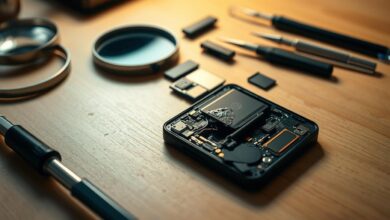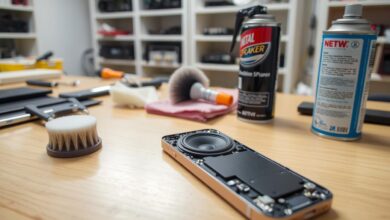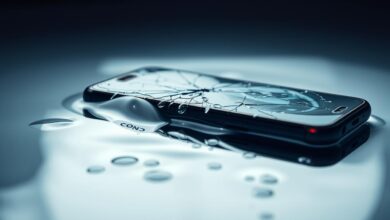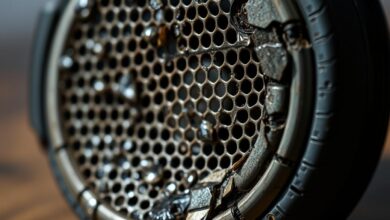get water out of phone sound
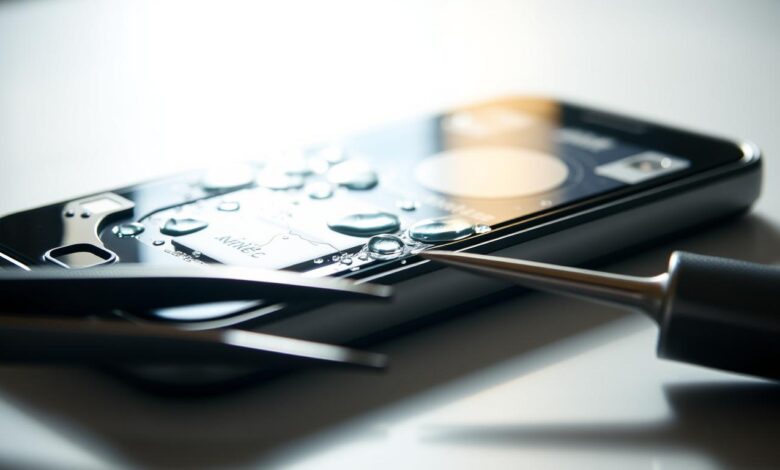
Ever dropped your phone in water by mistake? Or maybe it got wet and now the sound is all wrong? Water damage is a big problem, but you can fix it fast.
Water in your phone’s speaker can mess up your sound. It might sound bad or even not work at all. But, there are ways to fix it and get your phone’s sound back.
In this guide, I’ll show you how to deal with phone water damage. I’ll give you tips to make your phone’s sound work again.
Key Takeaways
- Act quickly to minimize water damage to your phone’s speaker.
- Turn off your phone immediately to prevent short circuits.
- Dry your phone thoroughly to prevent further damage.
- Use desiccants or silica gel packets to absorb moisture.
- Avoid using heat to dry your phone, as it can cause additional damage.
Understanding Water Damage in Phone Speakers
Knowing how water harms your phone’s speaker is key to fixing it. Water damage can cause big audio issues or even make the speaker stop working.
How Water Affects Speaker Components
Water can get into the speaker grills and hurt the parts inside, like the diaphragm and coil. It can cause corrosion, short circuits, or mechanical failures. This makes the sound quality go down because water messes with the diaphragm’s vibration.
Common Signs of Water in Your Phone’s Speaker
Here are some signs that water might be in your phone’s speaker:
- Muffled or distorted sound
- Crackling or buzzing noises
- Complete loss of sound
- Water droplets or condensation visible in the speaker grill
The Science Behind Speaker Water Damage
The science of speaker water damage is about corrosion and mechanical issues. Water can rust metal parts, like the speaker coil, causing lasting harm. It can also make the diaphragm stick or vibrate wrong, messing with sound quality.
To remove water from phone well, you need to know these facts and act fast to lessen the damage.
Act Fast: Immediate Steps After Water Exposure
When your phone gets wet, every second is crucial. Water can cause speaker damage, corrosion, and even make your phone stop working. Quick action and the right steps can help save your phone.
Power Off Your Device Immediately
The first thing to do is to power off your device right away. This stops short circuits that could harm it more. Don’t turn it on again until you’re sure it’s safe, as this can make things worse.
Remove Case and External Components
Then, take off any external parts like the phone case, SIM card, and SD card. This stops water from getting trapped and causing corrosion. Carefully remove these parts to help dry your phone.
Dry the Exterior Thoroughly
Use a soft cloth to dry the outside of your phone. Focus on the charging port, SIM card slot, and speaker grills. Don’t use heat or rub hard, as this can push water in or damage parts. For a phone water damage solution, be thorough but gentle. If you need water damaged phone help, these steps are a good start.
By acting fast and carefully, you can lessen damage to your phone. Quick and gentle steps are key to a successful phone water damage solution.
How to Get Water Out of Phone Sound Using Sound Frequencies
Sound frequencies can help get water out of your phone’s speaker. Water in the speaker can damage it and affect sound quality. Using sound frequencies is a way to fix this problem.
Using Water Eject Apps and Websites
Water eject apps or websites can remove water from your phone’s speaker. They use sound frequencies to push water out. To try this, visit a water eject website or download an app.
For example, you can check CNET’s guide on using low-frequency sounds to remove water from your iPhone.
There are many water eject apps for both iOS and Android. These apps offer different frequencies and sometimes a test feature to check your speaker.
Playing Low-Frequency Sounds to Expel Water
Low-frequency sounds are great for getting water out of phone speakers. They create vibrations that help move water out. To do this, play a low-frequency sound (around 165 Hz) at high volume for a few minutes.
Key steps to follow:
- Play the low-frequency sound at maximum volume.
- Continue for several minutes to ensure thorough water expulsion.
- Repeat if necessary, checking the speaker after each attempt.
Speaker Test After Water Removal
After trying to remove water with sound frequencies, test your speaker. Play music or a video with clear audio. If the sound is still bad, you might need to try again or use another method.
By following these steps and using sound frequencies, you can try to get water out of your phone’s sound system. This can help restore your device’s audio.
The Rice Method: Does It Really Work?
For years, people have used rice to dry wet phones. But does it actually work? This method involves putting your phone in a container of uncooked rice to pull out moisture. Many think it’s a good DIY fix for water damage, but its success is up for debate.
Proper Technique for the Rice Method
To use rice to dry your phone right, first turn it off and take off any accessories. Next, put your phone in a container full of uncooked rice, making sure it’s covered. Close the container and wait at least 48 hours before checking your phone.
Limitations and Potential Risks
The rice method might work sometimes, but it has its downsides. It can’t quickly pull moisture out of your phone’s inside parts. Also, it might not work well for serious water damage. Plus, rice dust or starch could get into your phone’s openings and harm it more.
Scientific Evidence on Rice Effectiveness
There’s not much research on how well the rice method works. Some studies say rice can dry out phones, but it’s not a sure thing. A better way might be to use desiccants or other drying agents made for electronics.
| Method | Effectiveness | Risks |
|---|---|---|
| Rice Method | Variable, depends on severity of water damage | Rice dust or starch causing further damage |
| Desiccants | Generally more effective than rice | Potential for damage if not used correctly |
Using Silica Gel and Desiccants
Silica gel is a top choice for fixing wet electronics, especially for water damage phone repair and phone submerged in water issues.
Why Silica Gel Works Better Than Rice
Silica gel beats rice for drying wet phones because it absorbs more moisture. Rice can leave dust and starch, but silica gel is clean and efficient. It’s perfect for phone submerged in water fix jobs.
How to Use Desiccants Effectively
To dry your phone with desiccants, put it in a sealed container with silica gel. Make sure the container is airtight to keep moisture out. The drying process can take days, so be patient. Here’s how to do it:
- Seal your phone in an airtight container with silica gel.
- Leave it undisturbed for at least 48 hours.
- Check the phone’s condition after 48 hours.
Where to Find Desiccants for Emergency Use
You can find silica gel packets in packaging for electronics, clothes, and food. They’re also available online or at hardware stores. Having silica gel packets ready can save your wet phone, offering a quick fix for water damage phone repair.
Gravity and Positioning Techniques
Gravity and positioning techniques are simple yet effective ways to get water out of your phone’s sound system. Water in your phone’s speaker can be hard to remove. But, using gravity can help.
Strategic Phone Positioning to Drain Water
One good way to get water out of your phone is to use gravity. Start by placing your phone face down on a dry surface. This lets gravity pull the water out of the speaker grills.
Key Positioning Tips:
- Make sure the phone’s speaker grills are facing downwards to let water escape.
- Don’t put your phone on a wet surface, like a towel or cloth.
- Keep your phone in this position for a few hours or overnight to drain more water.
| Positioning Method | Effectiveness | Precautions |
|---|---|---|
| Face Down | High | Avoid surfaces that retain moisture |
| Speaker Grill Down | Moderate | Ensure the surface is dry and flat |
| Angled | Low to Moderate | Be cautious of water flowing into other openings |
Gentle Tapping Methods
Gentle tapping can also help get water out of your phone’s speaker. Use a soft, dry cloth or a cotton swab to tap around the speaker area. This can help move trapped water without harming your phone.
Important Considerations:
- Tap gently to avoid pushing water further into the speaker.
- Don’t use sharp objects that could damage your phone’s speaker or other parts.
- Try tapping and positioning together for better results.
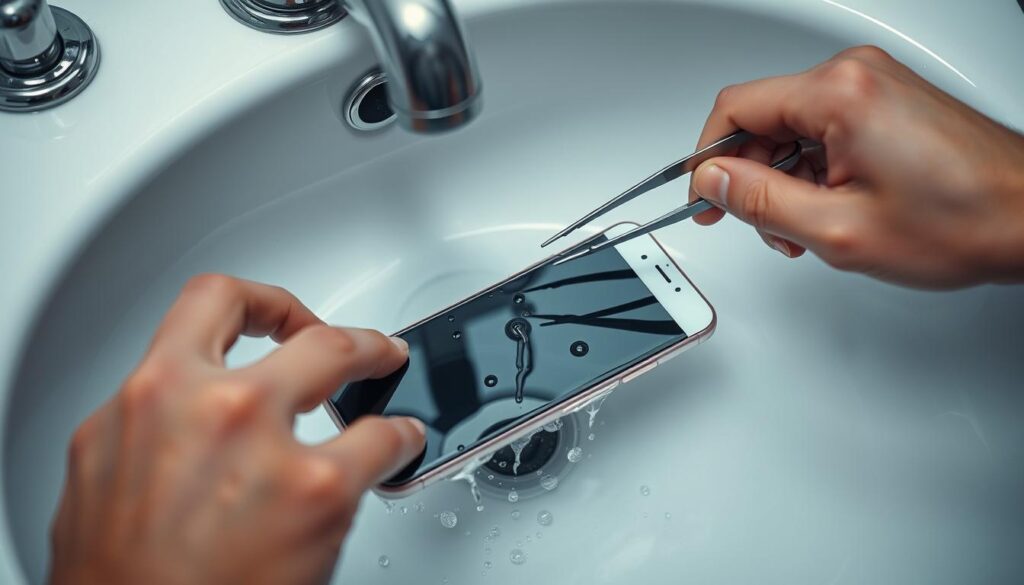
By using both strategic positioning and gentle tapping, you can remove water from your phone’s speaker. This is a key part of fixing your phone after water damage.
Using Compressed Air and Vacuum Methods
If your phone got wet, you can use compressed air or a vacuum to dry the speaker. This method works well if done carefully.
Safe Use of Compressed Air
Compressed air can help get water out of your phone’s speaker. But, you must use it safely to avoid harm. Hold the can upright to keep liquids out. Use short bursts of air to gently remove the water. Don’t hold the can too close to the speaker to avoid pushing the water in.
- Keep the can upright to avoid liquid entry.
- Use short bursts of air.
- Maintain a safe distance from the speaker.
Vacuum Techniques for Water Extraction
A vacuum can also remove water from your phone’s speaker. A gentle suction can pull out the moisture. It’s important to use a low-suction vacuum to protect the speaker. Be careful not to touch the speaker with the vacuum nozzle to avoid damage.
- Use a low-suction vacuum.
- Avoid touching the speaker with the nozzle.
- Be gentle to prevent damage.
Isopropyl Alcohol: When and How to Use It
Isopropyl alcohol can help fix water damage in phone speakers. Water can cause sound distortion and even speaker failure. It helps remove water from the speaker parts, making them work again.
Understanding How Alcohol Displaces Water
Isopropyl alcohol is thinner than water, so it can get into small spaces. It also evaporates fast, which helps prevent more damage. Using isopropyl alcohol can effectively remove water from phone sound systems.
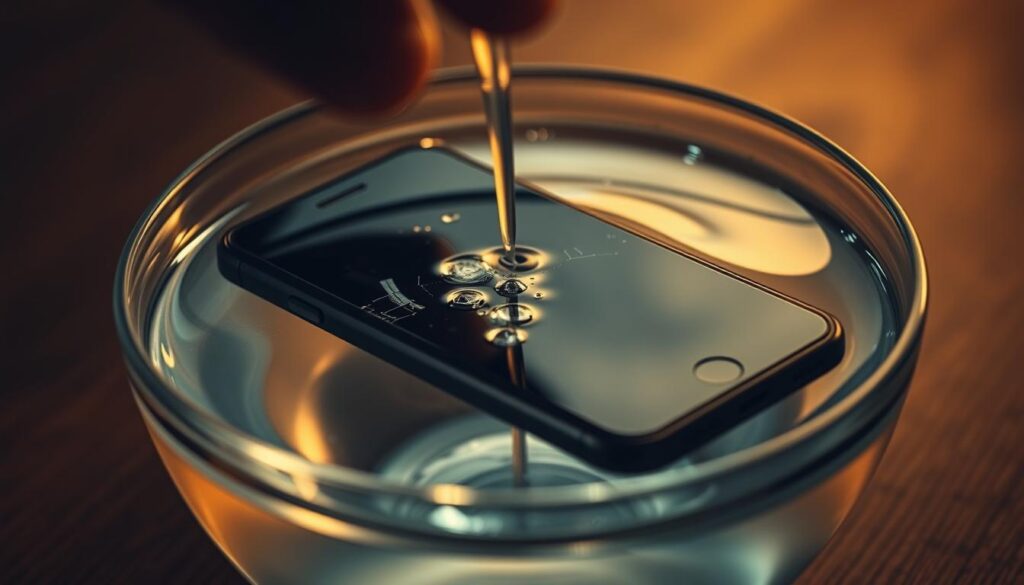
Step-by-Step Application Process
To fix water damage with isopropyl alcohol, follow these steps:
- Turn off your device right away to avoid short circuits.
- Take off any outer parts like cases or SIM cards.
- Soak a cotton swab with isopropyl alcohol but don’t soak it too much.
- Put the swab into the speaker grills to push out water.
- Use a dry cotton swab to soak up any leftover alcohol.
- Let the device dry completely before you turn it on again.
Safety Precautions When Using Alcohol
When using isopropyl alcohol, safety is key. Avoid letting alcohol get into the phone’s openings because it can harm internal parts. Use it carefully and make sure the device is dry before turning it on. If you’re not sure, get help from a professional.
Knowing how to use isopropyl alcohol right can help get water out of phone sound systems. It might even save your device from water damage.
Device-Specific Solutions
Whether you’re using an iPhone or an Android device, there are specific steps you can take to address water damage. Different manufacturers have developed unique features to help mitigate the effects of water exposure.
iPhone Water Eject Shortcuts and Features
iPhone users can use the “Water Eject” shortcut. It plays a sound frequency to expel water from the speakers. To access this feature, download the “Water Eject” shortcut from the Shortcuts app or a reliable source. Once installed, run the shortcut to play the sound frequency.
Experts say using specific sound frequencies can be an effective method for removing water from iPhone speakers.
“The sound frequency method is a clever hack for iPhone users to dry out their devices,”
Some newer iPhone models have built-in water ejection features. For more detailed instructions and to explore other repair options, visitfix-myspeaker.com.
Android Solutions for Water Damage
Android users can use various apps to eject water from their speakers using sound frequencies. Apps like “Water Eject” or “Speaker Cleaner” can be downloaded from the Google Play Store. These apps work similarly to the iPhone shortcut, playing specific sound frequencies to help remove water.
It’s crucial to follow the app’s instructions carefully to avoid causing further damage. If the problem persists, it’s advisable to seek professional help for water damage phone repair.
Water Resistance Ratings Explained
Understanding your device’s water resistance rating is crucial. Ratings like IP68 or IP67 indicate the level of protection against solid particles and water. For instance, an IP68 rating means the device is dust-tight and can withstand being submerged in water beyond 1 meter for a specified duration.
However, it’s essential to note that these ratings have limitations. They do not guarantee protection against all types of water exposure or damage. Always refer to your device’s manual or manufacturer’s website for specific information on its water resistance capabilities, especially if you’ve had a phone submerged in water fix issue.
Common Myths About Phone Water Damage
The world of phone water damage is full of wrong ideas. Many people try to fix their phones with methods that don’t work and can even hurt them more.
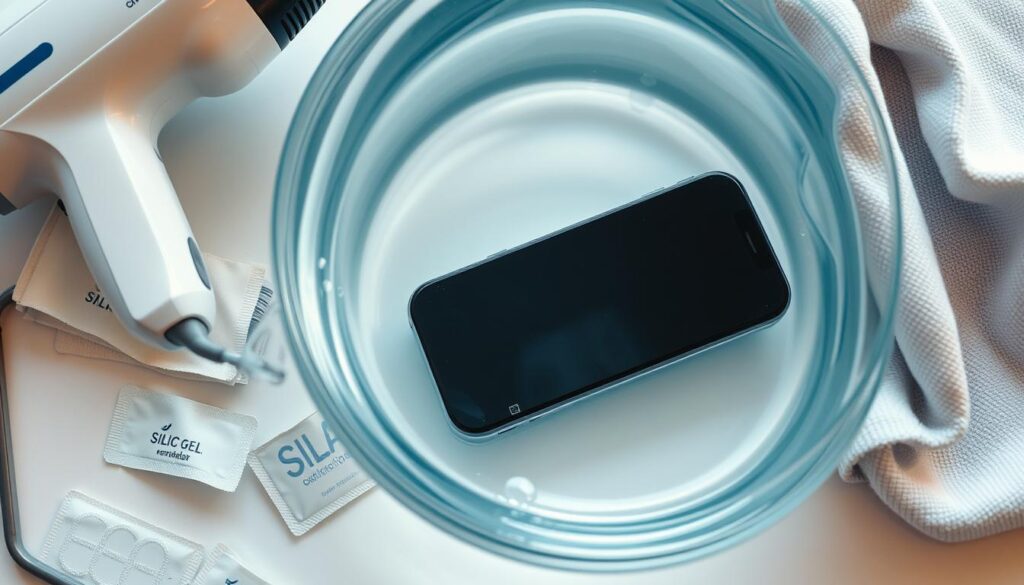
Debunking Popular DIY Remedies
Some DIY fixes are popular, but they’re not backed by science. For example, using a hair dryer can damage your phone’s parts because of the high heat. The rice method is also not as good as people think. It can leave dust and starch that can harm your device.
Instead, look into professional phone water damage solutions. These are made to safely get water out of your phone.
Harmful Practices to Avoid
It’s also key to know what not to do with a water-damaged phone. Don’t shake or blow into your phone, as this can push water deeper into it. Also, don’t use unproven methods like putting your phone in silica gel without sealing it properly. Knowing these myths and harmful practices can help you better fix your phone.
When DIY Methods Fail: Professional Repair Options
Many people start with DIY fixes for water damage in phone speakers. But when these don’t work, it’s time to call in the pros. Water damage can harm not just the speaker but other important parts of your phone too.
When to Seek Professional Help
If DIY fixes don’t solve the problem, it’s time to get help from experts. Look out for signs like sound distortion, speaker failure, or other phone issues.
- Persistent issues despite DIY efforts
- Visible corrosion or damage
- Uncertainty about the extent of the damage
What to Expect from Professional Repair Services
Professional repair services start with a detailed check-up. They figure out how bad the damage is and what needs fixing. You’ll get a clear explanation of the repairs, costs, and when it will be done.
Key aspects of professional repair services include:
- Expert diagnosis
- Transparent pricing
- Use of specialized tools and techniques
Average Costs of Water Damage Repair
Repair costs for water damage vary a lot. It depends on how bad the damage is and what kind of phone you have. Prices can be from $50 for small fixes to hundreds of dollars for bigger repairs or fancy phones.
Always ask for a quote before you agree to repairs. Good repair shops usually give free checks and quotes.
Preventing Future Water Damage
Protecting your phone from water damage is crucial. Use the right accessories, be cautious, and use built-in features. This way, you can lower the risk of water damage to your device.
Waterproof Cases and Accessories
Getting a waterproof case is a smart move to protect your phone. These cases keep your device dry even when it’s underwater. Choose a case that fits your phone well and has a high IP rating.
For example, a case with an IP68 rating can keep your phone safe underwater for up to 30 minutes. Also, consider screen protectors and phone pouches for extra protection. Waterproof phone pouches are great for swimming or kayaking.
| Accessory Type | Protection Level | Best For |
|---|---|---|
| Waterproof Case | High | General Use, Swimming |
| Water-Resistant Screen Protector | Medium | Accidental Splashes |
| Phone Pouch | High | Water Sports, Beach Activities |
Behavioral Habits to Reduce Risk
Changing your daily habits can help prevent water damage. Be careful with your phone near water. Don’t use it in the bathroom, by the pool, or near water bodies.
If you must use your phone near water, put it in a waterproof case or pouch. Also, be careful in rainy weather or when around liquids. This can prevent accidental spills or drops.
Water Detection Features in Modern Phones
Many phones today have water detection features. These can alert you to potential water damage. You can find these features in your phone’s settings or through special apps.
For example, some phones have moisture sensors in the charging port. These sensors can detect water and alert you to dry it out. Using these features can help you fix water damage early and prevent long-term damage.
Conclusion
Getting your phone wet can be really stressful. But, acting fast is key to lessening the damage. We’ve looked at ways to remove water from your phone’s speaker, like sound frequencies and the rice method.
If your phone gets wet, turn it off right away and take out any parts you can. You can try apps, sound frequencies, or silica gel to dry it. If these don’t work, you might need a pro to fix it.
To avoid costly repairs, protect your phone with waterproof cases and accessories. Be careful where you go, and use water detection features in new phones. This can really help prevent water damage.
Knowing the risks and taking steps to prevent them can keep your phone working well. If your phone does get wet, stay calm and act fast. This way, you can fix it and get back to using it as usual.
FAQ
How do I know if my phone has water damage?
Look for signs like distorted sound or a non-responsive screen. Also, check for corrosion on the SIM card tray or other openings. The Liquid Contact Indicator (LCI) on your device changes color when it’s wet.
Can I use a hair dryer to dry out my phone’s speaker?
No, using a hair dryer is not a good idea. It can push water deeper into your phone or damage it with too much heat. Instead, gently pat your phone dry with a soft cloth or use desiccants.
What is the best way to get water out of my phone’s speaker?
Using sound frequencies from water eject apps or websites can help. You can also try gently tapping your phone or using compressed air carefully.
Is the rice method effective for drying out a water-damaged phone?
The rice method might work a bit, but it has its downsides. It can let dust into your phone’s openings. Silica gel or other desiccants are often better choices.
How can I prevent water damage to my phone in the future?
Use a waterproof case and be careful when using your phone near water. Consider accessories with water-resistant ratings. Also, regularly check your phone for water damage signs.
Can I repair water damage on my phone myself?
For minor water exposure, DIY methods might work. But for serious damage, it’s safer to get professional help. This way, you avoid making things worse.
What should I do if my phone is submerged in saltwater?
Saltwater is more corrosive than freshwater, so act fast. Gently rinse your phone with fresh water to remove salt. Then, dry it using one of the methods mentioned. Saltwater damage can be harder to fix.
Are there any phone features that can help detect water damage?
Some phones have built-in water detection features or alerts. Check your phone’s settings or user manual to see if it has these features.
How much does it cost to repair water damage on a phone?
Repair costs vary a lot. It depends on the damage, your phone type, and the repair service. On average, you might pay between and over 0 for professional repair.
